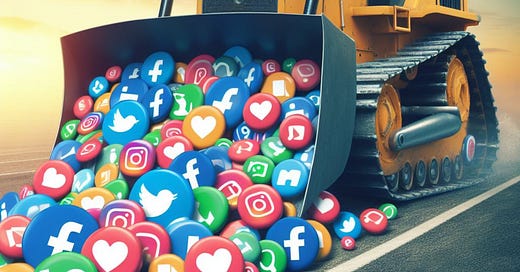Welcome! I'm Simon Owens and this is my media industry newsletter. If you've received it, then you either subscribed or someone forwarded it to you.
If you fit into the latter camp and want to subscribe, then you can click on this handy little button:
Let’s jump into it…
Platforms as a necessary evil
Apologies for the shorter-than-average newsletter today; I just got back from attending the Content Entrepreneur Expo in Cleveland and am still playing catch-up.
I’m not a natural-born-conference-goer, mainly because I’m an introvert who struggles at networking in large crowds, but I usually say yes when asked to give a talk at these events. Not only do I enjoy public speaking, but it’s good to sometimes get outside my comfort zone and meet media operators who aren’t already inside my orbit.
I attended several talks given by my fellow speakers, and the most consistent throughline I noticed in nearly all of them was this emphasis on owning your audience. When the speakers mentioned the large social media platforms, it was usually in the context of them being necessary evils — tools to reach top-of-funnel audiences that can be later converted into engaged customers. Nearly all of the recommended strategies centered on driving audiences to either owned-and-operated websites or platforms that hand over customer contact information to content creators (Shopify, Gumroad, Substack, etc…).
CEX didn’t exist a decade ago, but if it did, I’m sure the programming would have been entirely different. There would have been entire sessions on how to drive more Facebook video views or get more Twitter followers. Any talk of owned-and-operated websites would have focused entirely on leveraging platforms to drive pageviews in pursuit of programmatic ad monetization.
Look, I know it’s not exactly revelatory to point out that content creators have soured on social media, but the CEX talks made it clear that creators aren’t simply giving lip service to the idea of owned audiences; they’ve actually formed comprehensive strategies for moving their readers, listeners, and viewers onto websites where they exert more control.
Social media is never going away. Call me naive, but I actually think there’s incredible value to centralized content distribution, and I still spend a considerable amount of time each week playing in all of those sandboxes. But it’s also clear that the veil has been lifted as to what these platforms offer to creators. Most media business strategies going forward will prioritize engaged audiences over drive by visitors, and the owners of those businesses understand that the only true way to ensure continued engagement is to move the audience relationship off of social media.
What do you think?
Quick hits
Nicholas Carlson had a pretty epic run at Business Insider. He started out as a lowly blogger who mainly aggregated news stories, then published a series of blockbuster feature articles, then rose to editor-in-chief where he guided the publication through a monster acquisition and massive expansion. The outlet has definitely had its ups and downs, but it fared far better than many of its digital peers like Gawker, BuzzFeed, Mashable, HuffPost, and Vice. [Semafor]
Substack is making a concentrated effort to lure video creators onto its platform with the pitch that they can form a more direct relationship with their audiences than they get from platforms like Instagram and TikTok. [Substack]
This is kind of neat: Mamamia's podcast ad reads are now done by an AI voice that was created by amalgamating the voices of several Mamamia hosts. [Podnews]
Some of the most influential news coverage of the pro-Palestinian protests on college campuses is coming from Twitch streamers. [WashPo]
1440, a daily news aggregation newsletter, generates $15 million a year in ad revenue and spends upward of $1 million a month acquiring new email subscribers. It's a basic arbitrage game of ensuring the user acquisition cost is always lower than the lifetime value for each user. [Press Gazette]
Fast Company profiles a twice-a-year, profitable print magazine that has no online edition and isn't carried on newsstands. It has 24,000 paid subscribers and only partners with 10 sponsors per issue. [Fast Company]
This is a good overview of how Anna Wintour turned the Met Gala into the world's most coveted invite for celebrities. [The Media Mix]
Want a daily dose of media industry news?
I only send this newsletter out twice a week, but I curate industry news on a daily basis. Follow me on one of these social platforms if you want your daily fix:




So appreciate your involvement at CEX. Thanks Simon! - Joe Pulizzi